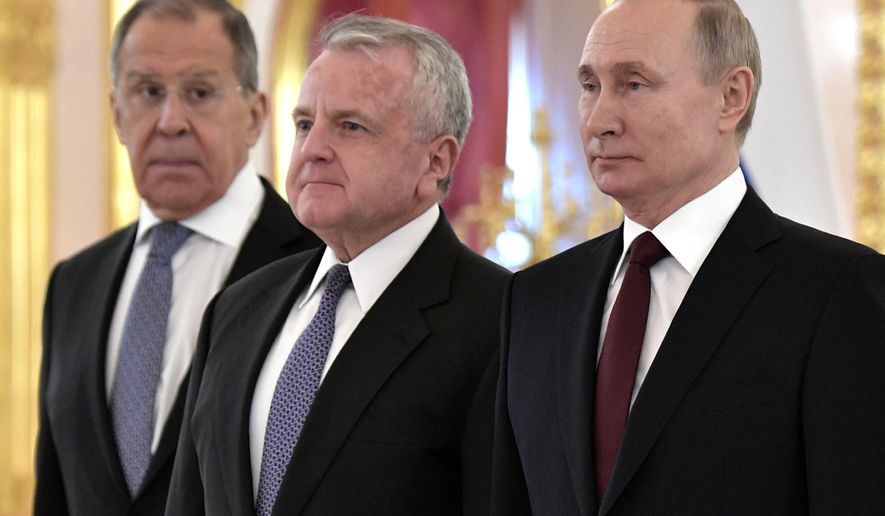OPINION:
Now that President Trump has been acquitted after the three-year-long impeachment ordeal, some of us expect him to start this dialogue that he pledged to initiate during the past electoral campaign and kept repeating many times over without following up.
At the quickly-approaching end of the first term, contrary to his impressive achievements in domestic and international trade affairs, the president can hardly mention any serious foreign policy successes. Mr. Trump can blame Congress, the deep state, the swamp or the media for sabotaging his policies, but this is irrelevant. It is he who makes the final decisions, but are we and the world more secure now than during the first Cold War?
U.N. Secretary-General Antonio Guterres has warned of the modern-day versions of the four horsemen in our midst. According to Mr. Guterres, climate change, mistrust, sinister technologies and geopolitical tensions continue to rise, preventing our addressing the existential threats of our time in a much more coordinated manner. Judging from rhetoric in Washington, almost all blame for the current sad state of affairs is accorded to Russia followed by China, Iran and North Korea. But the ultimate evils are Russia and its president, Vladimir Putin. During the impeachment hoax, their names have been mentioned as frequently as the U.S. president’s.
For Mr. Trump’s enemies, he and Mr. Putin are inseparable Siam twins, but in the end this witch hunt did not work. Having been maniacally absorbed with their efforts to remove the president from office, the never-Trumpers did not have time or desire to think about other major issues, including how to meet the looming existential threats facing America and mankind. In addition, if one compares the numbers of victims and level of chaos caused by U.S. actions and those which are attributed to post-communist Russia, the whole picture becomes fundamentally different.
Brown and American University Professors Catherine Lutz and David Vine have quantified the human and budgetary costs of the U.S. military interventions in post 9/11 wars. The numbers are staggering. More than 801,000 people have died due to direct war violence and several times as many lost their lives indirectly; more than 335,000 civilians have been killed as a result of the fighting; 21 million is the number of war refugees and displaced persons.
The U.S. federal price tag for the post-9/11 wars is more than $6.4 trillion. Even if all Western accusations of Russia are true, the results of its misdeeds represent only a tiny fraction of these numbers, and people in the know are well aware of this statistic. In this hateful political atmosphere, it was refreshing to hear the recent statement of National Security Adviser Robert O’Brien that the U.S. and Russia are about to start negotiations on arms control, on the nuclear issue which is “important to the safety of the world.”
Another positive signal came from the new U.S. ambassador in Moscow, John Sullivan, who publicly stated that he got specific instructions from Mr. Trump to improve relations with Russia.
Of course, we’ve heard the same instructions to other former and current senior U.S. foreign-policy officials with no visible progress, but it was nice to hear this frequently repeated message anyway.
Finally, to remain on the very narrow positive path, I cannot resist mentioning Mr. Trump’s commitment to plant 1 trillion trees for carbon sequestration in the atmosphere. I wonder if he was influenced by our advice on this subject printed in The Washington Times on the eve of his departure to the Davos International Economics Forum. Mr. Trump not only mentioned this idea in Davos, but during his Feb. 4 State of the Union address to Congress as well.
The president did not say that he wants to do this planting with Russia. But in this article, we explained that only U.S. and Russia together have enough free land in the Northern Hemisphere to plant this huge number of trees and, therefore, it would have been a good joint project to benefit both nations.
So far so good, but then a barrage of bad news has arrived. In Syria, there is a serious clash between Americans and Russians as Syrian troops escalate an offensive on the last remaining rebel enclaves in Idlib province. The Wall Street Journal reports that U.S. military officials have described the encounters as “more frequent, saying roadside confrontations between U.S. and Russian forces are happening daily and, sometimes, several times a day.” In case some people forgot Mr. Trump has pledged at least twice to bring U.S. troops home from this part of the world but it looks like they are still there.
At the same time about 20,000 U.S. troops will soon begin the largest military deployment to Europe in 25 years, joined by about 17,000 troops from 18 other NATO countries in the military exercise near Russian borders.
According to Lt. Gen. Christopher Cavoli, commander of U.S. Army Europe, “This ability is critical in projecting force at a moment’s notice. Our readiness reassures our allies and deters potential adversaries.” Newsweek’s recent headline screams “While the press and public focus on Iran, U.S. military prepares for war with Russia.” The U.S. Defense Department has also announced that it has deployed on the USS Tennessee submarine a new long-range missile with small nuclear warheads.
According to the Congressional Research Service, “While some argue that this warhead is a response to Russia’s so-called ’escalate to de-escalate’ strategy that will strengthen deterrence and raise the nuclear threshold, others contend that it will lower the threshold for U.S. use and increase the risk of nuclear war.” Here comes the fundamental question: What comes first, the U.S.-Russia dialogue or the Apocalypse?
⦁ Edward Lozansky is president of the American University in Moscow.




Please read our comment policy before commenting.